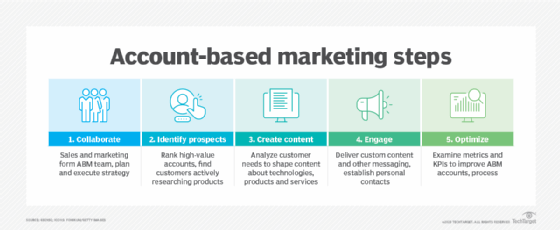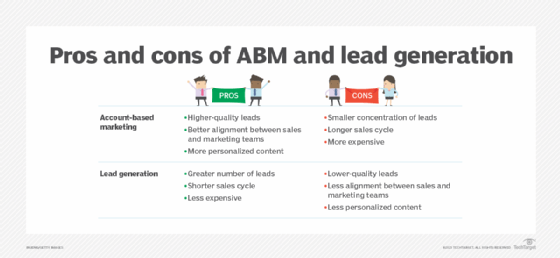What is account-based marketing? A guide to ABM strategy
Companies increasingly use ABM to target high-value accounts and boost sales revenue. Here's the lowdown on the key terms and technologies, plus expert advice on getting started.
Account-based marketing, or ABM, is a strategy that aims to identify high-value accounts and engage their buying teams with marketing content and personal communications tailored to their needs. The goal is to increase sales revenue quickly and efficiently.
ABM stands in contrast to demand generation, an older approach that's geared to collecting sales leads by using broad methods such as advertising and marketing automation to foster interest in products and services. Fundamentally, ABM is about bringing marketing methods and personnel into the sales process. It requires marketing and sales teams to collaborate on identifying key accounts, understanding their needs and challenges, and building closer relationships through custom content and personal interaction.
Read this overview to understand the essentials of ABM and click the links for the more detailed explanations and how-to articles included in this comprehensive guide.
Why is account-based marketing important?
You can't grasp ABM's importance without knowing some history. Salespeople had been selling into large accounts for decades before ABM came along in the early 2000s to give them a methodology and the digital marketing tools to target those accounts more directly and efficiently. This was a time when the attention of most marketers was on exploiting the newly popular web to reach as many people as possible.
ABM was initially used by IT services firms -- including Accenture, IBM and Xerox -- that had major tech vendors for their largest accounts, according to Rob Leavitt, senior vice president at Momentum ITSMA, a consultancy that claims to have coined the term in 2003 and developed the initial methodology. These early adopters were also distinguished by having large portfolios of offerings they could tailor for big clients.
Marketing is intended to build brand awareness and interest and foster a reputation for competence, but it wasn't widely done at the account level before ABM, Leavitt said. "The basic idea [of ABM] was applying marketing principles, strategies, vision and frameworks to individual accounts, and treating accounts as markets of one."
 Rob Leavitt
Rob Leavitt
The wisdom of investing significant marketing resources in a single account makes sense when you consider what's at stake. If a $50 million account were a separate business, it would have its own marketing department, Leavitt said. "The ABMer is the [chief marketing officer] of that account."
ABM grew as more companies faced the limitations of demand generation, which had the goal of finding as many leads as possible, then separating out the qualified ones.
"Some people call this fishing with spears versus fishing with nets," said Ray Pun, a senior director analyst at Gartner. "ABM is much more efficient and focused, and usually can generate better results than traditional demand generation."
Demand for ABM appears strong, even if the execution is often flawed. In a 2022 ABM benchmark survey of 279 B2B marketers by Momentum ITSMA and the ABM Leadership Alliance, ABM ranked as the No. 1 priority and accounted for an average of 28% of marketing budgets. Revenue growth from ABM was reported by 77% of respondents, and a similar number planned to increase their 2023 ABM spending. However, most were in the early stages of adoption.

How does ABM work?
ABM experts and software vendors generally agree on these five main steps, though the order varies:
- Collaborate. Bring sales and marketing together, choose representatives from each to be on the ABM team and plan a strategy. Maintain collaboration throughout the sales cycle.
- Identify prospects. Find people who match the ideal customer profile and are researching products. Consider purchase-intent data and ABM software to automate this step, as well as account mapping -- a visual representation of an account's key decision-makers and their roles in the buying process.
- Create content. Use analytics and AI to understand the needs of prospects and develop relevant custom content about your technology, products and services. Strive to create a positive account-based experience for the buying team.
- Engage. Deliver custom content and other messaging, and initiate personal contacts timed to the stages of the buyer journey.
- Optimize. Examine ABM metrics and KPIs to improve management of accounts and the overall ABM process. Common metrics include customer lifetime value, which totals the revenue a customer generates over the course of the relationship, and account engagement score, which measures a customer's website visits, event attendance and other interactions.
While ABM improves on demand generation, they're typically used together. Demand generation builds awareness and demand that results in lead generation. ABM then analyzes those leads to find and nurture high-value accounts. Other ways ABM and lead generation differ is that ABM is much slower and more expensive, while lead generation casts a wider net to find leads quickly.
"Deeply entrenched in the world of account-based marketing is the ability to collect account intelligence and insights about the organization, the buying teams and specific personas," Pun said. "That's how you deliver the more relevant communication."
Leavitt said the personalized websites and landing pages often pushed by ABM technology vendors can be useful, "but they're very much top of the sales funnel. It's the content and the conversation, especially, that you're really after with more senior-level people. Those kinds of mass digital tactics can help open doors, but you've got to walk in." Engaging with executives on a personal level, perhaps by inviting them to an executive briefing center, is one way to establish that rapport.
This is where sales enablement, another component of ABM, comes in. It's the process of equipping sellers to have strategic conversations after the door has been opened.
Sales enablement requires developing a value proposition that a company can put forth at any point in the ABM process, from traditional marketing channels to conversations, said Adam Bennington, head of consulting at Momentum ITSMA. (Some vendors and consultants use the term account-based selling to denote the sales team's role in ABM.)
Tech companies typically have innovation as a goal, so it's important for ABM practitioners to provide thought leadership tailored to buyers in those accounts, Bennington said. "A very well-crafted bit of thought leadership -- or micro thought leadership -- that is written to an individual about the organization can have a far, far greater impact than 2,000 emails and 20,000 media impressions."

What are the different types of ABM?
There are three main types of ABM:
- One to one. Sometimes called strategic ABM, this approach addresses the needs of individual accounts through highly customized methods.
- One to few. Also known as ABM lite, one-to-few ABM targets a handful of accounts -- typically fewer than a dozen -- that have similar needs and only require light customization.
- One to many. The third type, also called programmatic ABM, takes greater advantage of marketing automation technology to scale up efforts to more prospects, typically segmenting them in categories. While it sounds a lot like demand generation, it's still ABM because it targets specific accounts, though it is more likely to employ repurposed content than the other types.
Bennington said the third, scaled-up style of ABM can work with dozens or even hundreds of accounts that have a common thread, such as a product-line fit or a particular challenge. "You can anchor your effort to that and apply your influence with scale so that you get a degree of focus and coverage across a greater number of accounts."
Segmenting accounts -- by region, for example -- and ranking them in tiers according to their revenue potential helps in deciding how many resources to devote to them, according to Gerry Murray, a research director at IDC. "That's job No. 1. Make sure you understand the curve of opportunities and then figure out how to tier the various services."
The lowest-level accounts might get websites and emails customized to their industry, he said, while the next level up gets dedicated microsites. The next highest level might receive executive meetings and custom models that demonstrate the potential value. For top-level accounts, it might be worthwhile to have staff on site and spend a million dollars or more on content and other assets.

Account-based marketing framework
ABM proponents often publish frameworks that closely map to the main steps of ABM but augment them with best practices and advice about technical requirements.
For example, Gartner's ABM framework highlights integrating account-based business processes with existing, end-to-end-revenue processes, as well as bringing an account orientation to data management, program planning and analysis. Gartner also recommends implementing a technology stack that includes a dedicated account-based platform, data management tools, reporting and analytics software, marketing automation and workflow automation.
LinkedIn Marketing Solutions adds organizational advice like executive alignment and defining objectives, plus more specific ABM steps, such as developing an ideal customer profile.
What are the benefits of account-based marketing?
The point of ABM is to increase sales revenue; a secondary benefit is to economize on sales and marketing resources. Together, they boost profits.
Other ABM benefits include the following:
- Increased customer engagement.
- Better process automation.
- Accelerated sales cycles.
- More upselling and cross-selling.
What are the challenges of ABM?
Getting marketing and sales to work well together is perhaps the biggest challenge of ABM.
Some companies treat ABM like a marketing-led, more personalized form of demand generation that doesn't involve sales and marketing working closely, Pun said. Ideally, marketing's personalized content is matched by personalized outreach from the sales department.
 Gerry Murray
Gerry Murray
Until around five years ago, lack of integration between the software typically used by the two departments was a barrier, according to Murray.
"The marketing systems were designed to automate a bunch of marketing operations, tasks, processes and workflows, and the CRM system was designed to support a bunch of sales-specific processes," he said. "They were not initially -- and for many years -- designed as a single system, or two systems that are going to inherently and easily share information." The data schemes of the two disciplines didn't line up, either, requiring data integration and mapping between systems.
Lately, that integration has improved, in part because vendors that sell both kinds of systems -- including Oracle and Salesforce -- have done the work.
Pun said technology isn't usually the problem.
"Sometimes the technology vendor gets blamed when really it's the fact that the people and process elements are not in place," he said. "With any tool, the ability to bring sales and marketing teams together so they're working cohesively is not easy. That's really the crux of the issue."
ABM practitioners must also familiarize themselves with the sales cycle of each client, which can be long and continuous. Training marketing people to understand sales and accounts is another hurdle. "The best ABMers have sales experience," Leavitt said.
Other ABM challenges cited by respondents to the 2022 Momentum ITSMA and ABM Leadership Alliance survey include the following:
- Tracking and measuring results.
- Personalizing content and campaigns.
- Educating sales.
Account-based marketing best practices
One thing successful ABM programs have in common is all their messaging is "completely aligned," Pun said. That means email, LinkedIn InMail and other personal messaging reinforces the idea that the marketer understands who the recipient is and the problem they're trying to solve.
Soon-to-be-published survey data from Gartner provides further clues to best practices. "For most people who are running ABM programs effectively, marketing and sales are meeting on a weekly basis to walk through their account list," he said.
Also, the companies getting better results from ABM compared to traditional demand generation had marketing and sales staff who spent at least half their time using ABM methods.
Gartner typically advises clients who are new to ABM to run a pilot with 10-15 accounts that have a common use case or industry, Pun said. Then, determine who is on each buying team, their personas and the best messaging for each, including content types and engagement channels.
"Because there's a small number, you can really focus and see what's working and what's not," he said. A typical mistake is being too ambitious and running a pilot on hundreds of accounts.
It's also important for everyone involved, including executives, to agree on a definition of ABM and how success will be measured. The definition can be challenging, though, because marketing means different things to people depending on their experience.
How to build an account-based marketing strategy
Most of the work to develop an ABM strategy is in the managerial and technical requirements of unifying sales and marketing as part of the effort.
 Adam Bennington
Adam Bennington
Top-level support is needed to ensure that marketing is included in the sales process, Bennington said. "Any central governing function in an ABM program has to be able to underwrite and guarantee and enable and support sales and marketing alignment in a way where everyone is clear and understands their role and responsibility in the wider growth effort."
Murray took a similar view, calling ABM a holistic management challenge of getting different points of contact to work as a single brand in front of the customer. He also emphasized the technical infrastructure to support that effort.
"It all really depends on the data layer and the ability of the data to keep up with the customer across the many different touchpoints they might have with your company." For example, without integration across departments, sales might be unaware that a customer's billing department is angry about a possible overcharge and try to sell them a new product before the issue is resolved.
The ABM strategy is most likely to be championed by a sales leader and sales operations team, Murray said. Sales operations teams typically are involved because of the data integration, mapping and schema issues, and process triggers between the systems and analytics.
"Sales operations usually is either leading or implementing a lot of the underlying requirements to support an account-based marketing initiative," he added. They typically work with a dedicated marketing team that might include an industry specialist.
How to implement an account-based marketing strategy
In addition to tackling the organizational and data management requirements, choosing specialized technology is usually a necessary step in implementing an ABM strategy.
 Ray Pun
Ray Pun
Pun said most companies have a CRM system for managing customer contacts and histories, as well as a marketing automation platform for sending emails. If they use those platforms to target certain companies and personalize the emails, they've achieved simple ABM.
The rise of niche ABM platforms -- analysts often name 6sense and Demandbase as leaders -- came in response to a demand for digital marketing that went beyond email.
"No one is removing their email tool," Pun said. "But now they're adding an ABM platform to deliver relevant display advertising to create awareness with personas."
In the past five years or so, he said, companies have been able to take things a step further with systems that collect purchase-intent data, which tracks people's online activity to determine their interest in researching a purchase.
"It's very difficult to actually execute this with just your CRM and traditional marketing automation because you're going to come to a point where you either don't have enough data or can't just do email," Pun said. "You need a better way to scale those efforts."
Leavitt said it's important to have a process in place and people with strong sales and marketing skills. "Then you can layer on additional tools." He said most companies aren't getting full use out of their sales automation, CRM and marketing automation software or a unified view of data.
"The most effective ABM programs do not necessarily have more tools and technology, but they do get better use out of what they have."
Editor's note: TechTarget offers ABM and purchase-intent data software and services.






